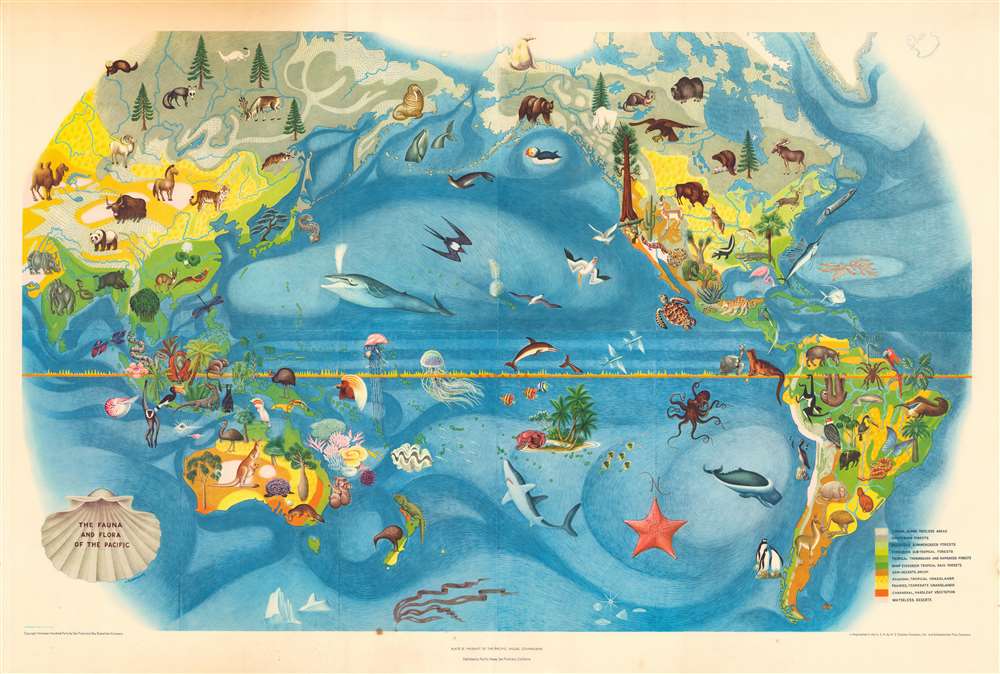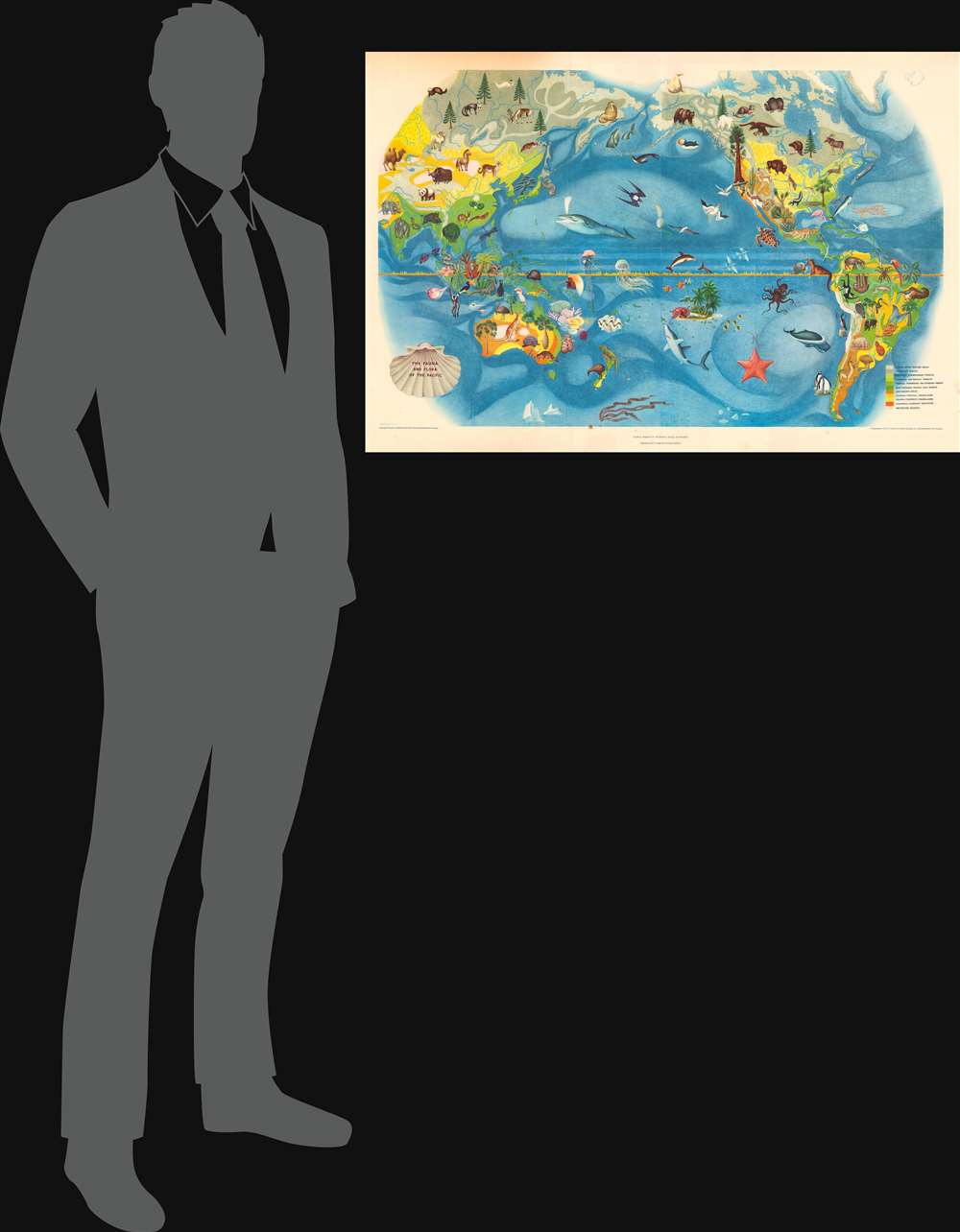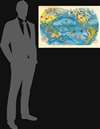This item has been sold, but you can get on the Waitlist to be notified if another example becomes available, or purchase a digital scan.
1940 Covarrubias Pictorial Map of Pacific Regional Plants and Animals
FaunaFloraPacific-covarrubias-1940
Title
1940 (dated) 23 x 34 in (58.42 x 86.36 cm)
Description
A Closer Look
Pictorial vignettes illustrate the plant and animal life (flora and fauna) of the Pacific. Seabirds (including puffins, seagulls, and pelicans) appear alongside whales, dolphins, a shark, and an octopus. Animal species native to certain areas are depicted and reinforce the Pacific's biodiversity. A giant tortoise and an iguana highlight the Galapagos Islands. A giant anteater, an Andean condor, and a capybara populate South America. A moose, a bison, and a pronghorn antelope appear in North America, along with a giant redwood. Across the Pacific Ocean, a panda, a yak, and a tiger occupy Asia, while an orangutan, a Komodo dragon, and a bird of paradise are illustrated in Indonesia and the other Pacific islands. A kangaroo, two koalas, and an echidna represent Australian wildlife and a kiwi bird appears in New Zealand. This print reproduces one of six murals created by Covarrubias for the Pacific House at the Golden Gate International Exposition (1939 - 1940).A History of the Murals
The murals were on display in Pacific House, the thematic centerpiece of the Golden Gate International Exposition. The six murals were titled: Peoples of the Pacific, The Flora and Fauna of the Pacific, Art Forms of the Pacific Area, Economy of the Pacific, Native Dwellings of the Pacific Area, and Native Means of Transportation in the Pacific Area. Two of the murals measured 9 feet by 13 feet (four panels each- 'Native Dwellings' and 'Transportation'), while the four others measured 16 feet by 24 feet. After the exposition, they were loaned to the American Museum of Natural History in New York City, where they were exhibited until 1953, when they were put into storage. In 1959 the AMNH decided to return the murals to Pacific House and shipped them back to San Francisco. In transit, one, Art Forms of the Pacific, went missing. They were subsequently exhibited at the World Trade Center, Ferry Building in San Francisco from 1959 until 2001. When Ferry Building renovations commenced in 2001, they were returned to the Treasure Island Development Association (TIDA) and put in storage. In March 2004, the Mexican Government approached TIDA with a proposal for a loan of the five remaining murals. Necessary conservation and restoration work was paid for by the Mexican government who sponsored four major exhibitions between 2006 and 2008. After the murals returned to the United States, a handful of exhibitions took place, but all five murals were never again exhibited together.The Golden Gate International Exposition
The Golden Gate International Exposition was a 'World's Fair' held to celebrate the two new bridges of San Francisco - The San Francisco Oakland Bay Bridge and the Golden Gate Bridge. It ran from February 18, 1939, through October 29, 1939, and from May 25, 1940, through September 29, 1940. The Exposition featured, among other attractions, the Tower of the Sun and a giant statue of 'Pacifica,' the goddess of the Pacific Ocean, highlighting the exposition theme, 'Pageant of the Pacific.' During the radio broadcast of the opening ceremony, President Franklin D. Roosevelt said:Washington is remote from the Pacific. San Francisco stands at the doorway to the sea that roars upon the shores of all these nations, and so to the Golden Gate International Exposition I gladly entrust a solemn duty. May this, America's World's Fair on the Pacific in 1939, truly serve all nations in symbolizing their destinies, one with every other, through the ages to come.Treasure Island, an artificial island constructed specially for the Exposition, had been intended to be a municipal airport, but instead was turned into a naval base during World War II. It remained Naval Station Treasure Island until 1997.
Publication History and Census
The original murals were created by Miguel Covarrubias in 1939 for the Golden Gate International Exposition. The sets of the six mural prints were copyrighted by the San Francisco Bay Exposition Company in 1940 and published by Pacific House, San Francisco, California. These prints appear on the market occasionally, sometimes in full sets but more often as individual sheets, like the present example. We note three cataloged examples of the present map in OCLC: Harvard University, the University of Michigan, and the National Library of New Zealand. The full set is well represented in institutional collections.Cartographer
Miguel Covarrubias (November 22, 1904 - February 4, 1957) (also known as José Miguel Covarrubias Duclaud) was a Mexican illustrator, caricaturist, painter, ethnologist, and art historian. Born in Mexico City, Covarrubias began producing illustrations and caricatures for materials published by the Mexican Ministries of Education and Communication after graduating from the Escuela Nacional Preparatoria in 1918. At just 19, although he spoke little English, the talented artist grant from the Mexican government to study in New York City. Covarrubias was introduced around New York City art circles by the Mexican poet José Juan Tablada and the New York Times critic Carl Van Vechten. His mastery attained instant recognition and he was soon booked to produce art for many of Manhattan's top magazines. Eventually, Covarrubias become a prominent illustrator and the premier caricaturist for Vanity Fair and The New Yorker. Covarrubias also worked on set designs, and painted murals, one of which was commissioned by the 1939-1940 Golden Gate International Exposition. He married Rosa Rolando in 1930. More by this mapmaker...




